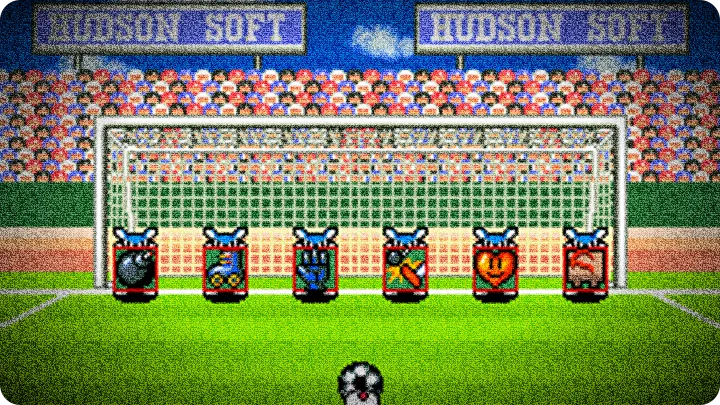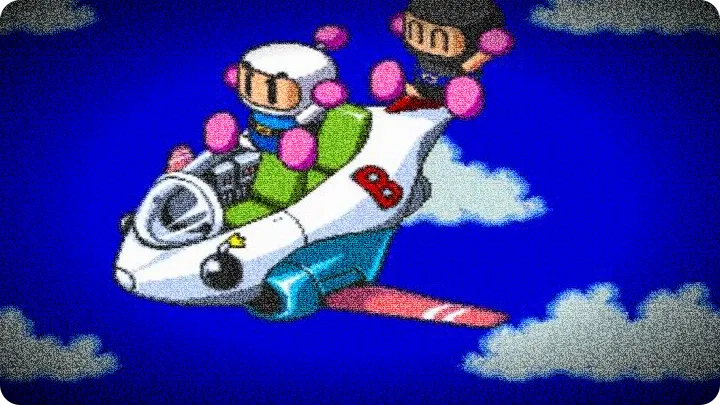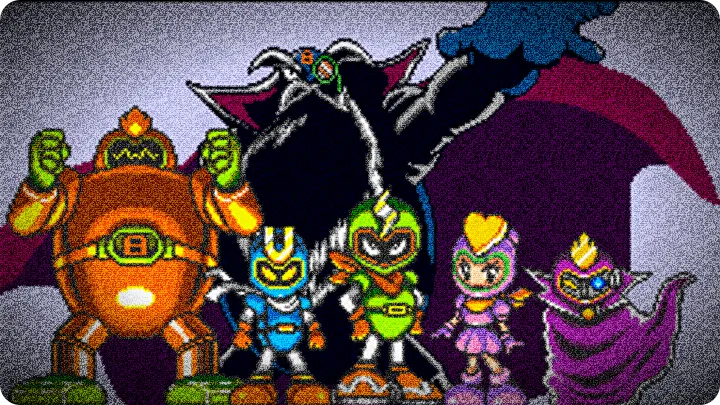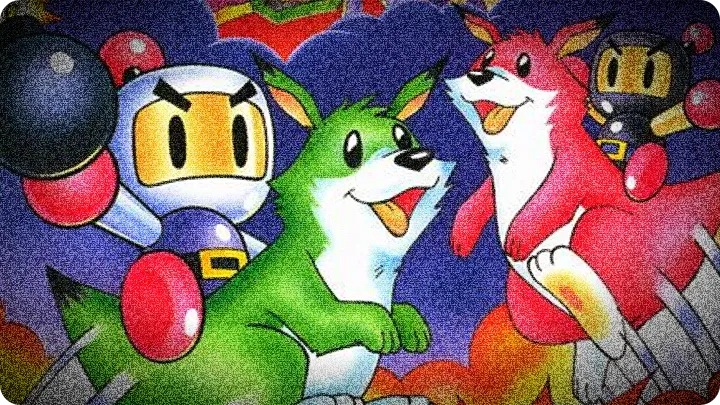 We hit power just after the SNES logo fades—cartridge clicks into place. Right away, Hudson Soft is flaunting its turf. Fun fact while we wait for the title: Hudson Soft, the team behind Bomberman, has been tinkering with multiplayer long before this generation. They popularized the multitap concept on the console and even bundled the peripheral with Bomberman in some regions. It feels like they built the whole super-couch-war experience around one plastic hub and five controllers.
We hit power just after the SNES logo fades—cartridge clicks into place. Right away, Hudson Soft is flaunting its turf. Fun fact while we wait for the title: Hudson Soft, the team behind Bomberman, has been tinkering with multiplayer long before this generation. They popularized the multitap concept on the console and even bundled the peripheral with Bomberman in some regions. It feels like they built the whole super-couch-war experience around one plastic hub and five controllers.
 I love that. The game feels built for bursts of chaos. We’re on Act 2 already and the explosions still look sharp—bright tiles, clear enemy sprites, and stages that change pace. They overhauled systems from previous entries, and it shows. New power-ups, new characters, and the “revenge” mechanic keep matches tense. Even fallen players can lob bombs from the sidelines, so grudges don’t end when someone goes down.
I love that. The game feels built for bursts of chaos. We’re on Act 2 already and the explosions still look sharp—bright tiles, clear enemy sprites, and stages that change pace. They overhauled systems from previous entries, and it shows. New power-ups, new characters, and the “revenge” mechanic keep matches tense. Even fallen players can lob bombs from the sidelines, so grudges don’t end when someone goes down.
 Gameplay highlights so far: the five-player matches are a revelation. When everyone is alive, it’s perfectly wild. When someone’s in “miso bomber” mode trying to swap back in, suspicion runs high. The Kangaroo power-up is a standout—an extra hit plus chain-row bombs or short jumps changes your approach entirely. The campaign blends top-down action with puzzle elements. Some rooms require timed pushes or bomb placement to progress. Controls remain crisp—drop a bomb, dash away, hope your chain reaction doesn’t swallow you. The new gadgets let you mix tactics instead of relying on brute force.
Gameplay highlights so far: the five-player matches are a revelation. When everyone is alive, it’s perfectly wild. When someone’s in “miso bomber” mode trying to swap back in, suspicion runs high. The Kangaroo power-up is a standout—an extra hit plus chain-row bombs or short jumps changes your approach entirely. The campaign blends top-down action with puzzle elements. Some rooms require timed pushes or bomb placement to progress. Controls remain crisp—drop a bomb, dash away, hope your chain reaction doesn’t swallow you. The new gadgets let you mix tactics instead of relying on brute force.

 That said, I have a few reservations. The single-player path can feel padded; some levels reuse the same gimmicks in a way that slows the momentum. Also, the Kangaroo can skew balance in multiplayer—when one player gets it early they essentially become the chaos engine and matches can devolve into hunting that single kangaroo. The AI in single-player sometimes telegraphs too much or behaves oddly in tight rooms; it’s great for a party, less compelling for a solo endurance run.
That said, I have a few reservations. The single-player path can feel padded; some levels reuse the same gimmicks in a way that slows the momentum. Also, the Kangaroo can skew balance in multiplayer—when one player gets it early they essentially become the chaos engine and matches can devolve into hunting that single kangaroo. The AI in single-player sometimes telegraphs too much or behaves oddly in tight rooms; it’s great for a party, less compelling for a solo endurance run.
 Memorable moments—there’s a later stage where the floors shift and you suddenly have to race across moving platforms while keeping tabs on bomb timers. We almost wiped the whole group there last night. The final gauntlet is clever in that it layers new mechanics on top of everything introduced earlier: corridors where you cannot place bombs, shields that absorb clicks, and a final encounter that forces you to think beyond simply dropping and running. It is less about spectacle and more about making you prove you can use everything you learned. We didn’t fight a surreal floating face; we fought patterns and consequences, which is satisfying in a practical way.
Memorable moments—there’s a later stage where the floors shift and you suddenly have to race across moving platforms while keeping tabs on bomb timers. We almost wiped the whole group there last night. The final gauntlet is clever in that it layers new mechanics on top of everything introduced earlier: corridors where you cannot place bombs, shields that absorb clicks, and a final encounter that forces you to think beyond simply dropping and running. It is less about spectacle and more about making you prove you can use everything you learned. We didn’t fight a surreal floating face; we fought patterns and consequences, which is satisfying in a practical way.
 Hot tips I’ve learned the hard way:
Hot tips I’ve learned the hard way:

- Never assume the Kangaroo is a free win—use its extra hit to bait teammates into traps, but be cautious in narrow rooms where you cannot dodge.
- Use the “revenge” bombard from the sidelines to herd opponents into your active players’ bombs. A well-timed toss can flip a match.
- Remote and long-range power-ups mix well; place bait bombs near crates to lure enemies and detonate from safety.
- Keep at least one power-up slot flexible—there are stages where speed matters more than raw power.
- In the final stages, preserve a remote bomb or a mine; some bosses nullify direct attacks but cannot stop indirect chain reactions.
 The audio keeps that classic chiptune bounce that makes you smirk and hum while you play. Levels transition with small melodic cues that make the campaign feel episodic. Graphically it is not trying to compete with the new 32-bit machines on the horizon, but the sprite work is expressive and the tile palettes do a lot with a little—there are nice touches like animated signs and tiny particle puffs on explosion edges.
The audio keeps that classic chiptune bounce that makes you smirk and hum while you play. Levels transition with small melodic cues that make the campaign feel episodic. Graphically it is not trying to compete with the new 32-bit machines on the horizon, but the sprite work is expressive and the tile palettes do a lot with a little—there are nice touches like animated signs and tiny particle puffs on explosion edges.
 Balance is the game’s main rough edge. In multiplayer the pace can skew wildly depending on item distribution; in single-player the design sometimes leans on cheap deaths when enemies get trapped with you in a small arena. Still, the additions—the extra characters to choose from, the kangaroo’s risk/reward, the revenge mechanic—make each match feel fresh even if the core map set is familiar. For gatherings and brief sessions it’s perfect. For a prolonged solo campaign it can feel repetitive.
Balance is the game’s main rough edge. In multiplayer the pace can skew wildly depending on item distribution; in single-player the design sometimes leans on cheap deaths when enemies get trapped with you in a small arena. Still, the additions—the extra characters to choose from, the kangaroo’s risk/reward, the revenge mechanic—make each match feel fresh even if the core map set is familiar. For gatherings and brief sessions it’s perfect. For a prolonged solo campaign it can feel repetitive.
 The final boss sequence was a neat payoff. It stretches you across screen types: a deceptive open arena that punishes overconfidence, followed by a cramped sequence where map awareness becomes survival. We had to relearn to bait, herd, and chain rather than sprinting and spamming. It is satisfying because it asks you to apply the whole toolkit instead of throwing a bullet-sponge at you.
The final boss sequence was a neat payoff. It stretches you across screen types: a deceptive open arena that punishes overconfidence, followed by a cramped sequence where map awareness becomes survival. We had to relearn to bait, herd, and chain rather than sprinting and spamming. It is satisfying because it asks you to apply the whole toolkit instead of throwing a bullet-sponge at you.

 Bottom line—this is a very good Bomberman that refines the series and injects multiplayer invention. It is not flawless—the pacing and balance in single-player can drag—but for what it aims to do on the SNES it mostly succeeds. Bring friends, charge the spare controllers, and expect glorious anarchy with a few frustrating moments. In other words: excellent party material with just enough depth to keep serious players engaged.
Bottom line—this is a very good Bomberman that refines the series and injects multiplayer invention. It is not flawless—the pacing and balance in single-player can drag—but for what it aims to do on the SNES it mostly succeeds. Bring friends, charge the spare controllers, and expect glorious anarchy with a few frustrating moments. In other words: excellent party material with just enough depth to keep serious players engaged.
more info and data about Super Bomberman 3 provided by mobyGames.com

